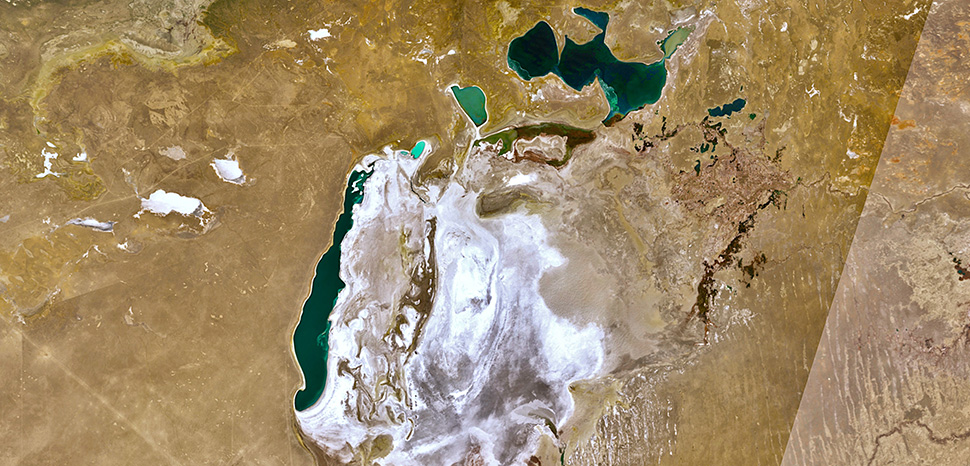
The Aral Sea, once the fourth-largest lake in the world, has lost over 90% of its area over the last few decades. As a result, the local economy has been heavily damaged, lands have become useless for agriculture, and the unique flora and fauna of the Aral region are now facing extinction. The region is home to one of the biggest environmental crises in the world, yet few global audiences are even aware of it.
Located between Northern Uzbekistan and Southern Kazakhstan, the Aral Sea was once a huge lake with an area of over 68,000 square kilometers (over 26,000 square miles). Historically, the Aral Sea relied on the Amu Darya and Syrdarya, two rivers in Central Asia. However, during the Soviet era, due to mismanagement of water resources, water from these rivers no longer reached the Aral Sea. As a result, the body of water started to shrink, and today the current area of the Aral Sea is just around 3,500 square kilometers (1,300 square miles), split into four smaller lakes.
Regional Impacts of the Shrinking Aral Sea
The shrinking Aral Sea is having devastating consequences for the region’s biodiversity. The dried part of the former lakebed has turned into a salt desert, which is now called “Aralkum.” Aralkum now covers over four million hectares. The decline in freshwater inflow has also led to increased salinity levels, giving rise to an environment that is unsuited to native plant and animal species. In the second half of the twentieth century, tigers and Bukhara deer went extinct. In the south part of the Aral region, ten bird types are about to disappear, and more than 40 bird species are now labeled as “endangered.” Additionally, 12 out of 28 fish types are also expected to vanish.
The Aral Sea crisis has also severely impacted the economies of surrounding regions, which have historically depended on fishing, agriculture, and animal husbandry. As the sea receded and salinity levels rose, a once-prosperous fishing industry collapsed, as many fish species cannot survive the harsh conditions. Eventually, declining fish stocks forced many to abandon their homes in search of alternative employment, leading to widespread depopulation in many areas.
Agriculture, another vital sector in the region, has also suffered. The combination of water scarcity, soil salinization, and increased desertification has rendered approximately 50,000 hectares of farmland unusable in recent years. Furthermore, one-third of grasslands have disappeared, making it hard for local people to feed their livestock.
Windstorms spread salt from Aralkum desert further afield in the region, damaging fertile land and worsening food insecurity in the Aral region. Dust storms also impact public health. The number of people with breathing problems increased and the number of anemia cases went up 20 times compared to statistics from 1960s. Women and children are the most vulnerable populations in this environmental health crisis due to the highly polluted and salinated water used for drinking.
Wider Implications from a Shrinking Aral Sea
The impact of the Aral Sea crisis extends beyond the immediate region, affecting broader environmental and climatic patterns. The creation of the Aralkum desert has contributed to regional climate changes, making the area more continental. Winter temperatures have dropped by an average of two degrees Celsius, while summer temperatures have risen by two degrees. These changes have shortened the growing season, delayed crop maturation, and increased the frequency of extreme weather events, all of which have had a ripple effect on agricultural production across the Aral and nearby regions. Moreover, the dust storms originating from the Aral Sea basin reached as far as the Tien Shan and Pamir mountains, causing glaciers on those mountains to melt faster.
Recognizing the severity of the Aral Sea crisis, both Uzbekistan and Kazakhstan have taken various steps to reduce the negative impacts of the Aral issue, improve people’s lives and save biodiversity. For instance, Uzbekistan has been implementing saxaul planting projects to reduce dust storms in the region. Saxaul is a type of desert plant that often grows in Central Asian deserts, it differs from other plants with its long roots and ability to strengthen mobile sands and slow down desertification. Furthermore, several wells were dug to supply local people with water, and artificial lakes were created to water animals in the Aral region. Uzbekistan also developed the tourism potentials of the Aral region. Now tourists from all over the world come to experience the unique Aral environment, watch the mysterious ship graveyard near the Aral Sea and enjoy the hospitality of Karakalpak people, who are a local minority living in this region.
Kazakhstan has also taken several steps toward restoring the Aral’s ecological balance. For instance, Kazakhstan built the Kok-Aral Dam with the support of the World Bank in 2005. The dam helped the country to partially revive the fishing industry in the northern basin of the Aral Sea. Kazakhstan also planted saxauls to prevent desertification and sandstorms.
Although Uzbekistan and Kazakhstan implemented different projects to reduce the negative impacts of the shrinking Aral Sea, a lot more should be done to improve the people’s lives and prevent future climate migrations. By raising global awareness about the issue, it would be possible to find some innovative solutions for ecological challenges in the region and attract investors to develop the area, offering employment opportunities to local people.
Overall, the Aral crisis is one of the largest environmental issues in the world, affecting millions of people in Central Asia. From accelerating the melting process in Tien Shan and Pamir glaciers to affecting public health in the Aral region, this is a very serious problem. While several projects were initiated with the support of international organizations like the World Bank and the UNDP, the region remains a neglected problem with lack of global awareness.
Comments
Post a Comment